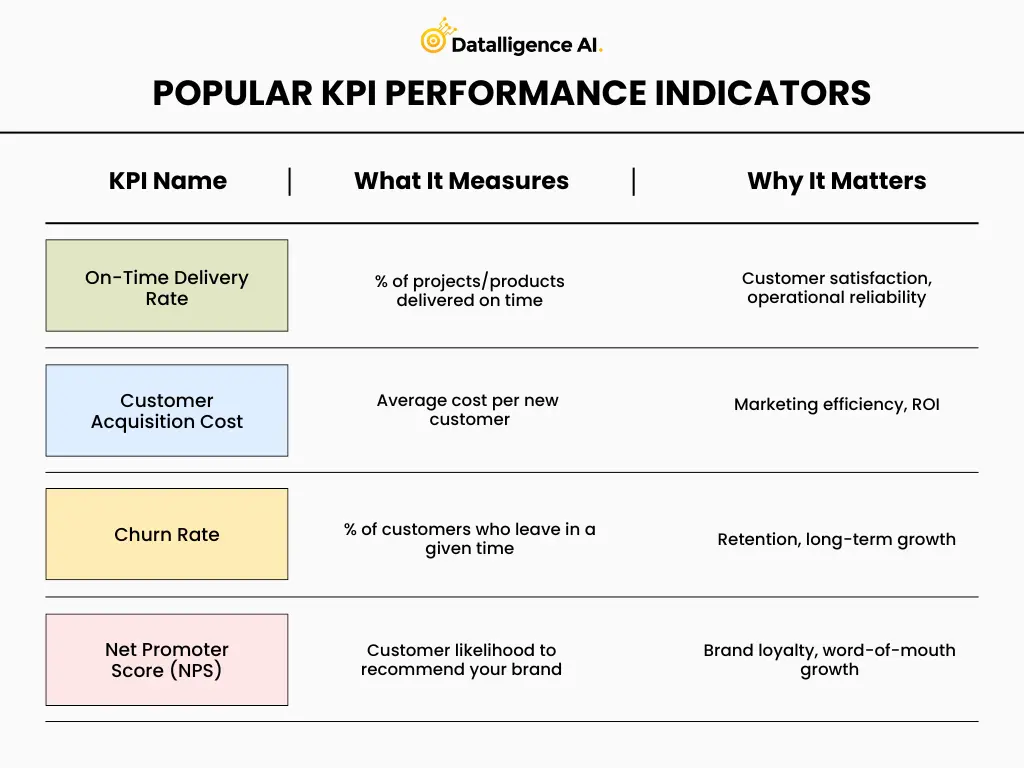Feeling like your business is busy but not sure if it’s really growing? You’re not alone. In the modern world of work, measuring what matters is the secret sauce for high-performance teams. Enter KPI performance indicators—the true game changers when it comes to tracking progress. But here’s the real boost: when you connect KPIs to OKRs (Objectives and Key Results), you’re not just measuring your journey; you’re steering your ship to success. Let’s break down how to wield these powerful tools for real, measurable results.
What Exactly Are KPI Performance Indicators?
Let’s start with the basics. KPI stands for Key Performance Indicator. These are the numbers, metrics, or signals that show you how well you’re really doing. They’re not just data points—they’re your business’s health check.
Think of KPIs as the dashboard in your car. If you don’t check your speed, fuel levels, or warning lights, you’ll either go too slow, run out of gas, or face a breakdown. KPI performance indicators work the same way—they keep you informed and allow you to take action before trouble hits.
But here’s the clincher: Not all KPIs are created equal. “KPI performance indicators” are the select few that truly align with your business goals and give you actionable insight. They’re the difference between vanity metrics (how many people liked your post) and impact metrics (how many people became paying customers)
Why Are KPI Performance Indicators Critical for Modern Organizations?
Why not just set goals and let the chips fall where they may? Here’s the truth: high-performing companies live and breathe by their numbers. Here’s what KPI performance indicators actually do for you:
- Clarity and Focus
KPIs cut through the noise. You don’t have to guess if things are working—your metrics tell the story, loud and clear. - Alignment Across Teams
When your business chooses its key metrics, everyone in the organization rows in the same direction. Sales, marketing, product, and customer support all understand which numbers matter most. - Early Warning System
Tracking KPIs allows you to spot potential problems as soon as they surface. Instead of reacting to disasters, you prevent them before they happen. - Continuous Improvement
KPIs encourage a culture of learning and iteration. You don’t just hit “set it and forget it”—you measure, adjust, and improve, quarter after quarter. - Accountability
With clear performance indicators, there’s no ambiguity about who’s responsible for what. It sets a culture of ownership and celebrates wins.

How Do You Select the Right KPI Performance Indicators?
Picking KPIs is both an art and a science. Here’s a quick checklist to get it right:
- Tie Every KPI to a Business Goal
Does this metric directly support your current objective? If not, cut it. - Make Them Measurable and Clear
KPIs must be quantifiable. “Improve customer service” is vague. “Increase customer satisfaction score to 90” is clear. - Keep Them Actionable
If the KPI reveals a problem, your team must be able to do something about it. - Review and Refine Regularly
Business priorities change, and so should your KPIs.
Example:
If your company wants to reduce customer churn, your key KPI performance indicator should be “Monthly Churn Rate.” Drill down further, and you might also track “Onboarding Completion Rate” to see if new customers actually finish onboarding—a common pain point that leads to churn.
Calculating and Tracking KPI Performance Indicators—Made Simple

Net Promoter Score (NPS)
- Survey customers: “On a scale of 0-10, how likely are you to recommend us?”
- Subtract % of detractors (score 0-6) from % of promoters (score 9-10).
If 70% are promoters and 10% are detractors, your NPS is 60 (solid!).
Tracking tips:
- Use digital dashboards for real-time insight (think Datalligence!).
- Set up automated reports so you’re never in the dark.
- Review performance indicators in regular team meetings.
KPI Performance Indicators Meet OKRs: A Powerhouse Combo
So, KPIs show you if you’re on track. But how do you make sure you’re setting the right track in the first place? That’s where OKRs—Objectives and Key Results—shine.
What are OKRs?
- Objectives: Ambitious, qualitative goals (“Delight our customers with world-class service”).
- Key Results: Specific, measurable milestones (“Achieve 95% on-time delivery rate this quarter”).
Here’s how the magic happens:
- Your KPI performance indicators become the Key Results in your OKRs, bringing both clarity and excitement to your strategic priorities.
Example OKR:
Objective: Become the most reliable SaaS provider in our segment.
Key Results:
- Raise uptime from 98.5% to 99.9%.
- Reduce average support ticket resolution time to under 2 hours.
- Maintain customer churn rate below 3%.
In this scenario, uptime, ticket resolution time, and churn rate are your KPI performance indicators. But housed within your OKR, they become not just statistics but missions for your team.
Making KPI Performance Indicators Come Alive: Best Practices
How can you ensure your KPI performance indicators are not just tracked, but acted upon? Here are some winning habits from top-performing teams:
- Start With Visibility
Don’t hide your KPIs in a spreadsheet. Use dashboards, wall charts, or weekly updates. The more visible, the more motivating. - Review as a Team
Make KPI check-ins part of your weekly or monthly rhythm. Discuss wins, challenges, and actions together. - Celebrate Milestones
Did you hit a tough target? Celebrate publicly—recognition builds momentum. - Connect the Dots
Don’t just track numbers for numbers’ sake. Encourage teams to explore what is driving the numbers (product bugs, process bottlenecks, customer feedback) and what actions they can take. - Stay Agile
As your business grows, your KPIs may need to shift. Be willing to evolve your KPI performance indicators as your priorities change. - Never Set and Forget
The world moves fast—review KPIs and OKRs at the end of each cycle to keep your business goals sharp and relevant.
Common Mistakes with KPI Performance Indicators (And How to Avoid Them)
Everyone makes mistakes. Here are common pitfalls (and how to dodge them):
- Too Many KPIs:
Focusing on everything is focusing on nothing. Less is more. - Vanity Metrics:
Tracking things that look good but don’t help you grow (e.g., app downloads instead of monthly active users). - Lack of Ownership:
If no one “owns” a KPI, it will slip through the cracks. - Ignoring Qualitative Feedback:
Combine data with stories and feedback for a fuller picture. - Outdated Metrics:
What mattered last year may not matter now. Keep KPIs fresh and relevant.
Wrapping It Up: KPI Performance Indicators as Your Growth Engine
Every ambitious business needs a way to know if it’s winning. KPI performance indicators are the north stars that keep your team on course, focused, and inspired. When you strengthen them with OKRs, you turn insight into action—setting the stage for extraordinary performance.
So, whether you’re tracking your on-time delivery rate, net promoter score, or revenue growth, remember:
- Start with clarity—pick only a few KPI performance indicators that move the needle.
- Review and act on your numbers—don’t let them gather dust.
- Use OKRs to give your KPIs purpose and context.
- Stay agile and celebrate every win.
Ready to turbocharge your business with actionable insights AND bold goals? Our platform, Datalligence, is built to help you track, share, and celebrate the KPI performance indicators that matter—paired seamlessly with OKRs. Let’s talk about how you can start winning, one measurable step at a time.










